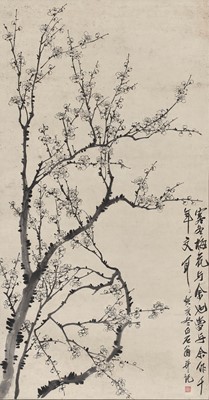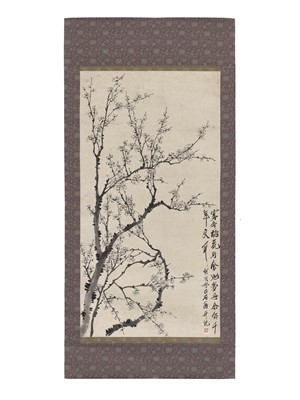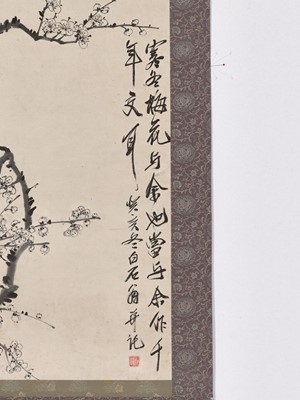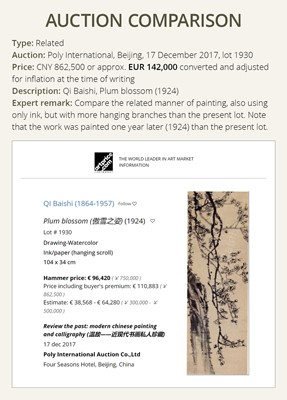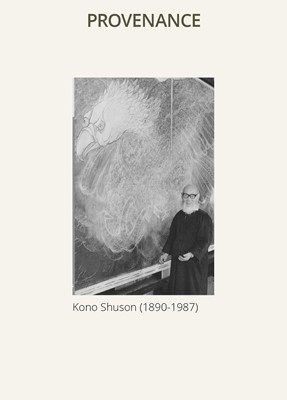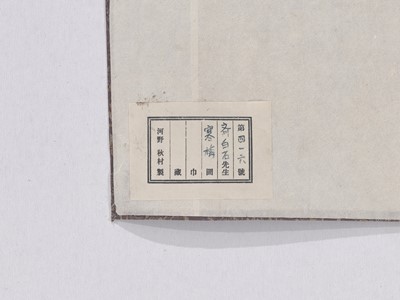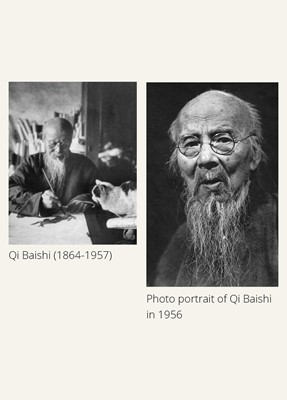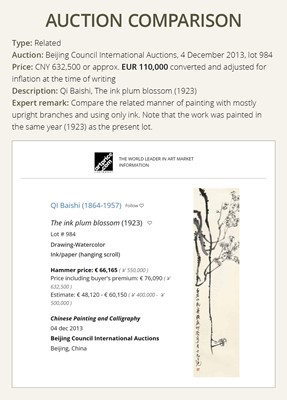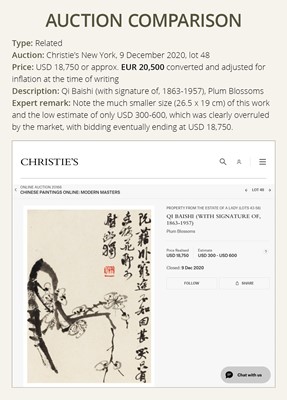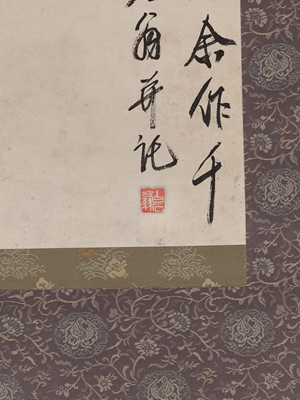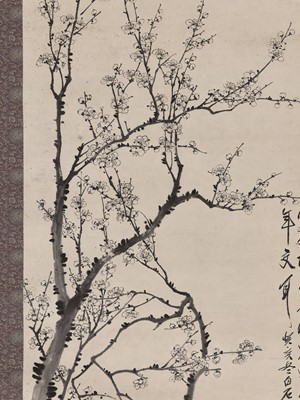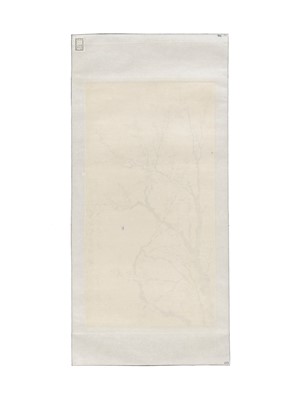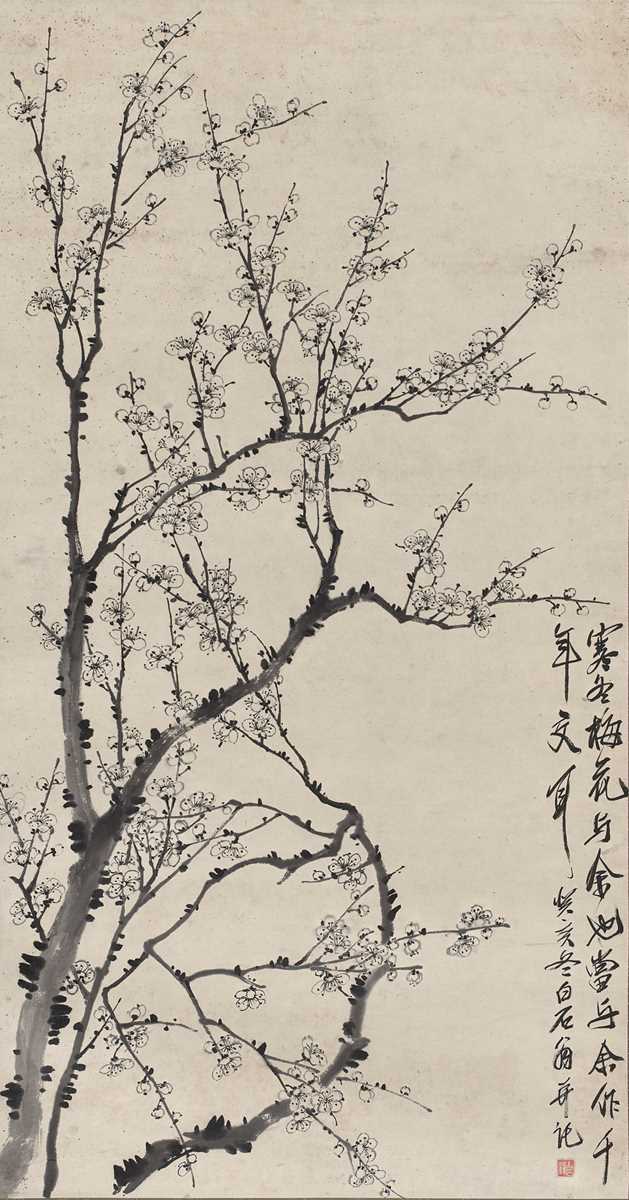9th Mar, 2023 13:00
TWO-DAY AUCTION - Fine Chinese Art / 中國藝術集珍 / Buddhism & Hinduism
204
‘PLUM BLOSSOMS’, BY QI BAISHI (1864-1957), DATED 1923
1923年齊白石款《寒梅圖》
Sold for €33,800
including Buyer's Premium
China. Ink on paper, with a Japanese silk brocade mounting. Exquisitely painted with a flowering plum tree in the winter, the branches and twigs mostly upright with few hanging down, the blossoms and buds neatly detailed, the thicker branches executed with bold, dynamic brushstrokes.
Inscriptions: Lower left, signed ‘Baishi weng’ (old man Baishi), inscribed ‘The winter plum blossoms and the rest of the year, a thousand-year friendship with the rest of the year’, and dated ‘in the Winter of the Year of Guihai’ (corresponding to 1923). The last character (託) indicates that this work was painted by Qi Baishi in order to entrust it to the recipient.
Provenance: Kono Shuson, Japan, acquired directly from the artist. A private collection, acquired from the above, and thence by descent. The back with an old Japanese paper label from Kono Shuson, stamped and inscribed ‘Dai yonhyaku-ju-roku-go, Sai Hakuseki sensei, Kono Shuson sei’ (Number 416, Painting of Winter Plum Blossoms by Master Qi Baishi, compounded by Kono Shuson). Two further paper labels, each inscribed ‘7541’. Kono Shuson (1890-1987) was a Japanese painter and a pivotal figure in promoting the Nanga (Chinese literati) school of paintings in Japan. With Tomioka Tessai (1836-1924) as a consultant, he founded the Nihon Nanga-in (Japan Literati Painting Academy) and visited China frequently, including his first documented visit in 1923, the year the present work was painted. This is when he probably met Qi Baishi for the very first time, shortly after Qi’s initial exhibition in Japan (see lot essay below). He then began to import Qi Baishi’s works to Japan, together with the paintings of other contemporary Chinese artists, selling them at the Takashimaya Department Store and other notable places. He always mounted such paintings on Japanese kakejiku scrolls. For a work bearing a similar label from Kono Shuson, see for example Bonhams Hong Kong, 2 March 2022, lot 29, by Zhang Daqian (1899-1983), Scholar under Willow Tree.
Condition: Good condition with some wear, soiling, and few minor abrasions.
Dimensions: Image size 106.5 x 56 cm, Size incl. mounting 144 x 68 cm
Qi Baishi painted plum blossoms in several styles, including copies of those painted by Jin Nong (1687-1763), which the present lot shares some affinities with, including the absence of colors. Qi Baishi's later plum paintings are primarily inspired by Wu Changshuo (1844-1927), who preferred bright colors and introduced an epigraphic aesthetic to the art of painting. Here however, Qi depicts the plum tree with its upward trunk and branches in calligraphic strokes of somber ink. The present painting can therefore be said to reflect an earlier style in painting plum blossoms for Qi Baishi, whose earliest works depicting this subject are dated by inscription to the year 1921, two years before the present work was executed. Qi's paintings are, first of all, reflections of things and feelings that he had personally experienced in life. In the case of plum blossoms, his fondness of this subject resulted from nostalgia for his hometown in Hunan, where his dwelling, named ‘Studio of Hundred Plums’, was surrounded by a plum grove.
Qi Baishi (1864-1957) is one of the world’s most important artists of the 20th century and has received countless honors and awards like no other painter in the People's Republic of China. He began his career as a carpenter, though he taught himself to paint using a manual from the Qin dynasty period. His style, which Qi Baishi developed in the second half of his life, is characterized by a powerful, spontaneous brushstroke. He expanded his subject matter to insects, birds, figures, animals, vegetation, and landscapes, and began to incorporate rich color into his compositions, painting in an ever-freer style. His works are focused on the spiritual, ephemeral, and mystical qualities of the human condition. In 1953, he was elected president of the China Artists Association, and one year later he was elected to the National People’s Congress.
Qi Baishi moved to Beijing in 1916 and earned his living there by selling paintings. However, his painting style was not welcome in Beijing at that time. Taking the advice of Chen Shizeng, Qi Baishi began his famous "initiating self-art-reform in senile age", which finally led Qi Baishi to tremendous success. In 1922, Chen Shizeng visited Japan. He brought some works by Qi Baishi for exhibition and sale. This was the first time that Qi Baishi's paintings were shown in Japan, and anywhere outside China. It is probable that Kono Shuson (the first owner of the present work) saw Qi’s work at this exhibition and was inspired to make his first trip to China less than a year later in 1923, meeting with the master for the first time. As recalled by Qi Baishi: “After Chen Shizeng returned to Beijing, I was told that all my paintings sold at very nice prices! Each of my paintings sold for at least 100 silver coins, and the landscape paintings were even more expensive, 250 silver coins for one that was only 60 inches long! I never imagined such prices in China! And I was also told that the French planned to exhibit my works and those of Shizeng in the Paris Art Expo. The Japanese were going to film my life and work for a movie! All this was just amazing! Afterwards, many foreigners came to Beijing to purchase my paintings, and I have been better off since then. It was Shizeng who helped me in my career and life - I will remember this forever.” (Baishi Laoren Zishu, Shandong Huabao Publishing House, 2000, pp. 131-133)
Auction result comparison:
Type: Related
Auction: Beijing Council International Auctions, 4 December 2013, lot 984
Price: CNY 632,500 or approx. EUR 110,000 converted and adjusted for inflation at the time of writing
Description: Qi Baishi, The ink plum blossom (1923)
Expert remark: Compare the related manner of painting with mostly upright branches and using only ink. Note that the work was painted in the same year (1923) as the present lot.
Auction result comparison:
Type: Related
Auction: Poly International, Beijing, 17 December 2017, lot 1930
Price: CNY 862,500 or approx. EUR 142,000 converted and adjusted for inflation at the time of writing
Description: Qi Baishi, Plum blossom (1924)
Expert remark: Compare the related manner of painting, also using only ink, but with more hanging branches than the present lot. Note that the work was painted one year later (1924) than the present lot.
Auction result comparison:
Type: Related
Auction: Christie’s New York, 9 December 2020, lot 48
Price: USD 18,750 or approx. EUR 20,500 converted and adjusted for inflation at the time of writing
Description: Qi Baishi (with signature of, 1863-1957), Plum Blossoms
Expert remark: Note the much smaller size (26.5 x 19 cm) of this work and the low estimate of only USD 300-600, which was clearly overruled by the market, with bidding eventually ending at USD 18,750.
1923年齊白石款《寒梅圖》
中國 ,紙本設色,日本裝幀。冬日寒梅圖,花瓣用筆勾,但行筆粗獷豪放。
款識:寒冬梅花與余也,當與余作千年交耳,癸亥冬白石翁並記。鈴印:白石翁。
來源:日本河野秋村收藏,直接購於齊白石處;私人收藏,購於上述收藏。保存至今。背面有河野秋邨紙標籤,可見“第四一六號,齊白石先生,寒梅圖,河野秋村製”。另外還有兩個紙標籤,都可見“7541”。河野秋村 (1890-1987) 是一位日本畫家,也是推動日本南畫派的關鍵人物之一。富岡鉄斎 (1836-1924) 作為顧問,他創立了日本文人畫院,並經常訪問中國,包括他在1923 年首次有記錄的訪問,即本拍品的創作年份。這是他第一次見到齊白石的時候,在齊白石首次在日本舉辦展覽後不久。隨後,他開始將齊白石與其他中國現代藝術家的畫作一起進口到日本,在高島屋百貨商店和其他著名場所出售。他總是把這樣的畫裝裱在日本的掛物捲軸上。比較另一件河野秋村同一標籤的拍品,見張大千(1899-1983)的《文人圖》,香港邦瀚斯,2022年年3月2日,編號29。
品相:狀況良好,有一些磨損、污漬和少量輕微擦傷。
尺寸:畫面106.5 x 56 厘米,總144 x 68 厘米
齊白石很喜歡畫梅花,臨摹金農(1687-1763 年)所畫的梅花,本拍品與其有一些相似之處。齊白石後期的梅花主要受吳昌碩(1844-1927)的啟發,吳昌碩喜歡鮮豔的色彩,並將金石美學引入繪畫藝術。這幅畫可以說反映了齊白石早期畫梅花的風格,據款識記載,齊白石最早描繪梅花的作品創作於 1921 年,比本拍品完成早兩年。齊白石的作品首先是他在生活中親身經歷的事物和感受的反映。在梅花方面,他對這個題材的喜愛源於對湖南家鄉的懷念,他的住所名為“百梅祠”,四周環繞著梅林。
齊白石於1916年移居北京,以賣畫為生。然而,他的畫風在當時的北京並不受歡迎。在陳師曾的建議下,齊白石開始了著名的“晚年自修”,最終使齊白石取得了巨大的成功。1922年,陳師曾訪日。他帶去了一些齊白石的作品進行展覽和銷售。這是齊白石的畫作首次在日本乃至中國以外的地方展出。河野秋村(本拍品的第一任擁有者)很可能在這次展覽中看到了齊白石的作品,受到啟發,他的第一次中國之行,即一年後的 1923 年,第一次見到大師。
拍賣結果比較:
形制:相近
拍賣:北京匡時國際拍賣有限公司,2013年12月4日,lot 984
價格:CNY 632,500(相當於今日EUR 110,000)
描述:齊白石《墨梅》(1923)
專家評論:比較相近的右上角樹枝的繪畫風格,以及只使用墨水畫。請注意此幅畫和我們的拍品畫於同一年 (1923) 。
拍賣結果比較:
形制:相近
拍賣:北京保利國際拍賣有限公司,2017年12月17日,lot 1930
價格:CNY 862,500(相當於今日EUR 142,000)
描述:齊白石《傲雪之姿》 (1924)
專家評論:比較相近的繪畫風格,以及只使用墨水畫,但畫有更多樹枝。請注意此幅畫畫於我們的拍品的後一年 (1924)。
拍賣結果比較:
形制:相近
拍賣:紐約佳士得,2020年12月9日,lot 48
價格:USD 18,750(相當於今日EUR 20,500)
描述:齊白石(款,1863-1957)《梅》
專家評論:請注意此畫尺寸(26.5 x 19 厘米)小很多,以及預估價較低 ,僅有USD 300-600,市場並不認同此估價,因此最後落槌價為USD 18,750。
China. Ink on paper, with a Japanese silk brocade mounting. Exquisitely painted with a flowering plum tree in the winter, the branches and twigs mostly upright with few hanging down, the blossoms and buds neatly detailed, the thicker branches executed with bold, dynamic brushstrokes.
Inscriptions: Lower left, signed ‘Baishi weng’ (old man Baishi), inscribed ‘The winter plum blossoms and the rest of the year, a thousand-year friendship with the rest of the year’, and dated ‘in the Winter of the Year of Guihai’ (corresponding to 1923). The last character (託) indicates that this work was painted by Qi Baishi in order to entrust it to the recipient.
Provenance: Kono Shuson, Japan, acquired directly from the artist. A private collection, acquired from the above, and thence by descent. The back with an old Japanese paper label from Kono Shuson, stamped and inscribed ‘Dai yonhyaku-ju-roku-go, Sai Hakuseki sensei, Kono Shuson sei’ (Number 416, Painting of Winter Plum Blossoms by Master Qi Baishi, compounded by Kono Shuson). Two further paper labels, each inscribed ‘7541’. Kono Shuson (1890-1987) was a Japanese painter and a pivotal figure in promoting the Nanga (Chinese literati) school of paintings in Japan. With Tomioka Tessai (1836-1924) as a consultant, he founded the Nihon Nanga-in (Japan Literati Painting Academy) and visited China frequently, including his first documented visit in 1923, the year the present work was painted. This is when he probably met Qi Baishi for the very first time, shortly after Qi’s initial exhibition in Japan (see lot essay below). He then began to import Qi Baishi’s works to Japan, together with the paintings of other contemporary Chinese artists, selling them at the Takashimaya Department Store and other notable places. He always mounted such paintings on Japanese kakejiku scrolls. For a work bearing a similar label from Kono Shuson, see for example Bonhams Hong Kong, 2 March 2022, lot 29, by Zhang Daqian (1899-1983), Scholar under Willow Tree.
Condition: Good condition with some wear, soiling, and few minor abrasions.
Dimensions: Image size 106.5 x 56 cm, Size incl. mounting 144 x 68 cm
Qi Baishi painted plum blossoms in several styles, including copies of those painted by Jin Nong (1687-1763), which the present lot shares some affinities with, including the absence of colors. Qi Baishi's later plum paintings are primarily inspired by Wu Changshuo (1844-1927), who preferred bright colors and introduced an epigraphic aesthetic to the art of painting. Here however, Qi depicts the plum tree with its upward trunk and branches in calligraphic strokes of somber ink. The present painting can therefore be said to reflect an earlier style in painting plum blossoms for Qi Baishi, whose earliest works depicting this subject are dated by inscription to the year 1921, two years before the present work was executed. Qi's paintings are, first of all, reflections of things and feelings that he had personally experienced in life. In the case of plum blossoms, his fondness of this subject resulted from nostalgia for his hometown in Hunan, where his dwelling, named ‘Studio of Hundred Plums’, was surrounded by a plum grove.
Qi Baishi (1864-1957) is one of the world’s most important artists of the 20th century and has received countless honors and awards like no other painter in the People's Republic of China. He began his career as a carpenter, though he taught himself to paint using a manual from the Qin dynasty period. His style, which Qi Baishi developed in the second half of his life, is characterized by a powerful, spontaneous brushstroke. He expanded his subject matter to insects, birds, figures, animals, vegetation, and landscapes, and began to incorporate rich color into his compositions, painting in an ever-freer style. His works are focused on the spiritual, ephemeral, and mystical qualities of the human condition. In 1953, he was elected president of the China Artists Association, and one year later he was elected to the National People’s Congress.
Qi Baishi moved to Beijing in 1916 and earned his living there by selling paintings. However, his painting style was not welcome in Beijing at that time. Taking the advice of Chen Shizeng, Qi Baishi began his famous "initiating self-art-reform in senile age", which finally led Qi Baishi to tremendous success. In 1922, Chen Shizeng visited Japan. He brought some works by Qi Baishi for exhibition and sale. This was the first time that Qi Baishi's paintings were shown in Japan, and anywhere outside China. It is probable that Kono Shuson (the first owner of the present work) saw Qi’s work at this exhibition and was inspired to make his first trip to China less than a year later in 1923, meeting with the master for the first time. As recalled by Qi Baishi: “After Chen Shizeng returned to Beijing, I was told that all my paintings sold at very nice prices! Each of my paintings sold for at least 100 silver coins, and the landscape paintings were even more expensive, 250 silver coins for one that was only 60 inches long! I never imagined such prices in China! And I was also told that the French planned to exhibit my works and those of Shizeng in the Paris Art Expo. The Japanese were going to film my life and work for a movie! All this was just amazing! Afterwards, many foreigners came to Beijing to purchase my paintings, and I have been better off since then. It was Shizeng who helped me in my career and life - I will remember this forever.” (Baishi Laoren Zishu, Shandong Huabao Publishing House, 2000, pp. 131-133)
Auction result comparison:
Type: Related
Auction: Beijing Council International Auctions, 4 December 2013, lot 984
Price: CNY 632,500 or approx. EUR 110,000 converted and adjusted for inflation at the time of writing
Description: Qi Baishi, The ink plum blossom (1923)
Expert remark: Compare the related manner of painting with mostly upright branches and using only ink. Note that the work was painted in the same year (1923) as the present lot.
Auction result comparison:
Type: Related
Auction: Poly International, Beijing, 17 December 2017, lot 1930
Price: CNY 862,500 or approx. EUR 142,000 converted and adjusted for inflation at the time of writing
Description: Qi Baishi, Plum blossom (1924)
Expert remark: Compare the related manner of painting, also using only ink, but with more hanging branches than the present lot. Note that the work was painted one year later (1924) than the present lot.
Auction result comparison:
Type: Related
Auction: Christie’s New York, 9 December 2020, lot 48
Price: USD 18,750 or approx. EUR 20,500 converted and adjusted for inflation at the time of writing
Description: Qi Baishi (with signature of, 1863-1957), Plum Blossoms
Expert remark: Note the much smaller size (26.5 x 19 cm) of this work and the low estimate of only USD 300-600, which was clearly overruled by the market, with bidding eventually ending at USD 18,750.
1923年齊白石款《寒梅圖》
中國 ,紙本設色,日本裝幀。冬日寒梅圖,花瓣用筆勾,但行筆粗獷豪放。
款識:寒冬梅花與余也,當與余作千年交耳,癸亥冬白石翁並記。鈴印:白石翁。
來源:日本河野秋村收藏,直接購於齊白石處;私人收藏,購於上述收藏。保存至今。背面有河野秋邨紙標籤,可見“第四一六號,齊白石先生,寒梅圖,河野秋村製”。另外還有兩個紙標籤,都可見“7541”。河野秋村 (1890-1987) 是一位日本畫家,也是推動日本南畫派的關鍵人物之一。富岡鉄斎 (1836-1924) 作為顧問,他創立了日本文人畫院,並經常訪問中國,包括他在1923 年首次有記錄的訪問,即本拍品的創作年份。這是他第一次見到齊白石的時候,在齊白石首次在日本舉辦展覽後不久。隨後,他開始將齊白石與其他中國現代藝術家的畫作一起進口到日本,在高島屋百貨商店和其他著名場所出售。他總是把這樣的畫裝裱在日本的掛物捲軸上。比較另一件河野秋村同一標籤的拍品,見張大千(1899-1983)的《文人圖》,香港邦瀚斯,2022年年3月2日,編號29。
品相:狀況良好,有一些磨損、污漬和少量輕微擦傷。
尺寸:畫面106.5 x 56 厘米,總144 x 68 厘米
齊白石很喜歡畫梅花,臨摹金農(1687-1763 年)所畫的梅花,本拍品與其有一些相似之處。齊白石後期的梅花主要受吳昌碩(1844-1927)的啟發,吳昌碩喜歡鮮豔的色彩,並將金石美學引入繪畫藝術。這幅畫可以說反映了齊白石早期畫梅花的風格,據款識記載,齊白石最早描繪梅花的作品創作於 1921 年,比本拍品完成早兩年。齊白石的作品首先是他在生活中親身經歷的事物和感受的反映。在梅花方面,他對這個題材的喜愛源於對湖南家鄉的懷念,他的住所名為“百梅祠”,四周環繞著梅林。
齊白石於1916年移居北京,以賣畫為生。然而,他的畫風在當時的北京並不受歡迎。在陳師曾的建議下,齊白石開始了著名的“晚年自修”,最終使齊白石取得了巨大的成功。1922年,陳師曾訪日。他帶去了一些齊白石的作品進行展覽和銷售。這是齊白石的畫作首次在日本乃至中國以外的地方展出。河野秋村(本拍品的第一任擁有者)很可能在這次展覽中看到了齊白石的作品,受到啟發,他的第一次中國之行,即一年後的 1923 年,第一次見到大師。
拍賣結果比較:
形制:相近
拍賣:北京匡時國際拍賣有限公司,2013年12月4日,lot 984
價格:CNY 632,500(相當於今日EUR 110,000)
描述:齊白石《墨梅》(1923)
專家評論:比較相近的右上角樹枝的繪畫風格,以及只使用墨水畫。請注意此幅畫和我們的拍品畫於同一年 (1923) 。
拍賣結果比較:
形制:相近
拍賣:北京保利國際拍賣有限公司,2017年12月17日,lot 1930
價格:CNY 862,500(相當於今日EUR 142,000)
描述:齊白石《傲雪之姿》 (1924)
專家評論:比較相近的繪畫風格,以及只使用墨水畫,但畫有更多樹枝。請注意此幅畫畫於我們的拍品的後一年 (1924)。
拍賣結果比較:
形制:相近
拍賣:紐約佳士得,2020年12月9日,lot 48
價格:USD 18,750(相當於今日EUR 20,500)
描述:齊白石(款,1863-1957)《梅》
專家評論:請注意此畫尺寸(26.5 x 19 厘米)小很多,以及預估價較低 ,僅有USD 300-600,市場並不認同此估價,因此最後落槌價為USD 18,750。
Zacke Live Online Bidding
Our online bidding platform makes it easier than ever to bid in our auctions! When you bid through our website, you can take advantage of our premium buyer's terms without incurring any additional online bidding surcharges.
To bid live online, you'll need to create an online account. Once your account is created and your identity is verified, you can register to bid in an auction up to 12 hours before the auction begins.
Intended Spend and Bid Limits
When you register to bid in an online auction, you will need to share your intended maximum spending budget for the auction. We will then review your intended spend and set a bid limit for you. Once you have pre-registered for a live online auction, you can see your intended spend and bid limit by going to 'Account Settings' and clicking on 'Live Bidding Registrations'.
Your bid limit will be the maximum amount you can bid during the auction. Your bid limit is for the hammer price and is not affected by the buyer’s premium and VAT. For example, if you have a bid limit of €1,000 and place two winning bids for €300 and €200, then you will only be able to bid €500 for the rest of the auction. If you try to place a bid that is higher than €500, you will not be able to do so.
Online Absentee and Telephone Bids
You can now leave absentee and telephone bids on our website!
Absentee Bidding
Once you've created an account and your identity is verified, you can leave your absentee bid directly on the lot page. We will contact you when your bids have been confirmed.
Telephone Bidding
Once you've created an account and your identity is verified, you can leave telephone bids online. We will contact you when your bids have been confirmed.
Classic Absentee and Telephone Bidding Form
You can still submit absentee and telephone bids by email or fax if you prefer. Simply fill out the Absentee Bidding/Telephone bidding form and return it to us by email at office@zacke.at or by fax at +43 (1) 532 04 52 20. You can download the PDF from our Upcoming Auctions page.
How-To Guides
How to Create Your Personal Zacke Account
How to Register to Bid on Zacke Live
How to Leave Absentee Bids Online
How to Leave Telephone Bids Online
中文版本的操作指南
创建新账号
注册Zacke Live在线直播竞拍(免平台费)
缺席投标和电话投标
Third-Party Bidding
We partner with best-in-class third-party partners to make it easy for you to bid online in the channel of your choice. Please note that if you bid with one of our third-party online partners, then there will be a live bidding surcharge on top of your final purchase price. You can find all of our fees here. Here's a full list of our third-party partners:
- 51 Bid Live
- EpaiLive
- ArtFoxLive
- Invaluable
- LiveAuctioneers
- the-saleroom
- lot-tissimo
- Drouot
Please note that we place different auctions on different platforms. For example, in general, we only place Chinese art auctions on 51 Bid Live.
Bidding in Person
You must register to bid in person and will be assigned a paddle at the auction. Please contact us at office@zacke.at or +43 (1) 532 04 52 for the latest local health and safety guidelines.
